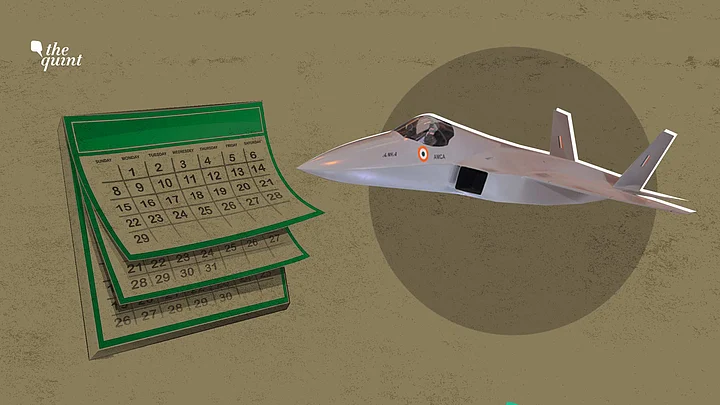(This is the second article in The Quint’s two-part series on India’s fifth generation fighter aircraft, to be developed by DRDO and produced by HAL and an Indian private company. You can read the first part here.)
If all goes well, metal cutting for India’s own Fifth Generation Fighter Aircraft (FGFA) may commence as early as 2021. The preliminary design of AMCA is ready as on date.
DRDO project, not ‘HAL AMCA’
First things first, contrary to popular perception, it is not “HAL AMCA”. As of now, only a few modules such as landing gear, AAR probe, some parts of the composite structure, etc have been outsourced to HAL. Top HAL sources this author reached out declined to comment on the AMCA as it is a “DRDO program”.
My messages to Project Director Dr AK Ghosh did not elicit a reply. There are unconfirmed reports that DRDO’s Aeronautical Development Agency (ADA) may shift the AMCA project out of Bengaluru. Whether this is for convenience or to maintain “social distancing” from HAL, we don’t know yet.
The AMCA program is closely guarded by DRDO; to an extent where even HAL is kept in the loop only on “need to know” basis.
Dr AK Ghosh, known for his role in the LCA project, and his team of about two dozen scientists from ADA steer the project from the leafy ADA campus at Bengaluru.
A couple of IAF test pilots and flight test engineers from ADA’s National Flight Test Centre (NFTC) are involved in shaping the UI and an intense flight test programme (about 1700 sorties) to follow. Their energy level, enthusiasm and optimism about the AMCA is almost infectious.
When Can India Deploy the First AMCA?
ADA is reportedly targeting 2025 for first flight of the prototype. HAL hopes to commence production by 2026-28, though there’s not much under their control right now.
To a keen observer, AMCA timelines—even considering project sanction and funding in 2021—sounds overly optimistic. Concurrent programs like Twin-engine Deck Based Fighter (TEDBF), LCA Mk 2, and Omni Role Combat Aircraft (ORCA) are also vying for attention and resources. Though some osmosis and synergy between these projects can be expected, ADA and the lead integrator’s capacity will surely be tested with so many developmental projects running concurrently. The first casualty could well be timeline.
This is an unfortunate ‘damned if you do; damned if you don’t’ scheme we have curated for ourselves.
Projection of a realistic timeline is often untenable and could force user services to import. On the other hand, DRDO/DPSU holding services hostage to a constantly slipping timeline erodes operational readiness.
Synergy and Project Management
Largely owing to a legacy of ‘over-promise & under-deliver’, the services, DRDO and PSUs function under a serious trust deficit. “Truth doesn’t get funding”, a senior officer opined. ADA’s public pronouncements on the AMCA display a high level of confidence, possibly drawn from the LCA experience.
Air Marshal Philip Rajkumar (Retd), veteran test pilot, founder-director of NFTC and author of two books on the LCA pointed out four key areas around which the success of AMCA will pivot:
- Conflict resolution between stakeholders (DRDO, IAF, HAL, private partner)
- Astute project management
- Creation of an integral, permanent cadre of flight test crew (TPs & FTEs) within DRDO/ADA
- Successful testing and timely delivery of the indigenous 110 kN engine
“All stakeholders must come to a common understanding about project timeline, technical aspects, financial resources and key decision points. LCA happened because a bold investment was made. If the government resorts to drip feed funding, the project will sputter along without much success. The need is for a big bang investment”, Air Marshal Rajkumar added from his LCA experience.
AMCA Will Need Strict Quality Control and Strong Leadership
One of the critical weaknesses in public sector aviation manufacturing is production engineering — the ‘last mile connectivity’ and ‘quality control’ that makes the whole greater than the sum of its parts. This assumes even greater importance when we enter the domain of stealth where such deficiencies will hurt. Our penchant to take shortcuts, attention to detail, aesthetics, reliability of mechanical systems, maintainability and serviceability—all need quantum improvement.
The AMCA, like the LCA, will be a “piece of cake” to fly, as per a test pilot involved with the program. Sound production engineering should pass on the same delight to maintainers on ground.
No mention of the LCA project is complete without acknowledging the role of Dr Kota Harinarayana who spearheaded the LCA campaign through its most crucial phases. His visionary leadership and credibility powered the program. No 1000-mile screwdriver from Delhi could interfere with the program with him around.
Same is said for Kelly Johnson. Lockheed Martin’s Skunk Works® that has won seven Collier Trophies delivered the SR-71 ‘Blackbird’ with “small empowered teams, streamlined processes and the culture that values the lessons learned when you are bold enough to attempt something that hasn’t been done before”.
As the AMCA evolves, it will face many hurdles, idiosyncrasies, pet-peeves and diverse — often contradictory — requirements. India needs its own Kelly Johnson — or a person with similar traits — to navigate the program through this minefield. Sadly, our past forays into indigenous design & development have violated almost all of Kelly’s 14 Rules & Practices. For AMCA to reach full operational clearance without taking hostages, another Kota Harinarayana must rise from the masses.
(Capt KP Sanjeev Kumar is a former navy test pilot and blogs atwww.kaypius.com. He can be reached at @realkaypius. He has flown over 24 types of fixed and rotary wing aircraft and holds a dual ATP rating on the Bell 412 and AW139 helicopters. This is an opinion piece. The views expressed above are the author’s own. The Quint neither endorses nor is responsible for them.)
